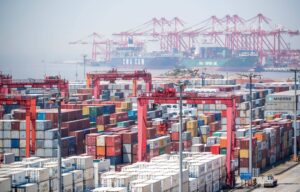- Transition finance is funding dedicated to decarbonizing hard-to-abate and emissions-intensive sectors, such as steel and cement manufacturing.
- Companies in these sectors must prepare for an orderly transition, as failure to act will bring immense risk in a decarbonizing world economy.
- Nurturing a thriving transition finance market is critical to mitigating systemic economic and financial risks.
The transition finance market provides a unique opportunity for Africa to leapfrog to low-carbon technologies and business models, which will address climate risks and enhance the continent’s global competitiveness.
Though lacking a universal definition, transition finance refers to funding dedicated to decarbonizing hard-to-abate and emissions-intensive sectors, such as steel and cement manufacturing.
It is key to overcoming financial barriers to sustainability in the industries essential for economic development yet major contributors to greenhouse gas emissions. Companies in these sectors must prepare for an orderly transition, as failure to act will bring immense risk in a decarbonizing world economy.
In a report published in July, titled Transition and Systemic Risk in the South African Banking Sector, the South African Reserve Bank noted that firms in high-emitting sectors that do not plan are likely to see their future income expectations revised downward, their credit ratings downgraded, and the value of their assets depreciate. This, in turn, translates into higher credit risk for lenders.
Nurturing a thriving transition finance market
For example, South Africa’s steel industry may become increasingly uncompetitive if it does not shift to low-carbon production processes. At the same time, the automotive manufacturing sector faces an uncertain future as key export markets move towards electric models. Meanwhile, coal mining groups and their logistics partners are bracing for a long-term decline in demand and pricing, meaning they will need to adapt to survive for decades.
The report notes that between 2013 and 2035, South Africa faces transition risks totaling R2.1 trillion in present value terms, with the financial sector’s exposure close to R1 trillion.
With this in mind, nurturing a thriving transition finance market is critical to mitigating systemic economic and financial risks – and to taking advantage of new technologies.
These funding mechanisms will be particularly impactful in Africa as they will spur economic development, tackle climate change, and ensure no sector and its workforce is left behind in the energy transition.
Hard-to-abate sectors are vital for infrastructure and industrial growth. By providing financial support for their decarbonisation, Africa can continue developing economically without compromising its climate goals.
Energy efficiency and green buildings
The continent can also enhance competitiveness as carbon border taxes are implemented and multinationals seek to green their supply chains. According to an analysis by MSCI, companies operating in the most emissions-intensive sectors with a higher share of revenue from alternative energy, energy efficiency, and green buildings saw significantly faster earnings growth than their peers in the seven-and-a-half years to March 2023.
Including hard-to-abate sectors in the journey towards a sustainable future is also aligned to the principles of a just transition, where workers in legacy industries are protected and upskilled.
Considering Africa’s relatively low historical emissions but high vulnerability to climate change impacts, transition finance is clearly an appropriate mechanism that aligns with the continent’s developmental needs and climate resilience targets.
To unlock the full potential of transition finance and ensure the market’s effectiveness, regulators must develop a harmonized taxonomy. This will provide investors with clear guidance on what constitutes transition finance and what qualifies as a legitimate transition project.
In line with best practices, companies would need credible transition plans with intermediate targets, and the use of proceeds would need to be clearly defined. For instance, a steel producer could raise capital to convert a mill from blast furnaces to electric arc furnaces fed with scrap steel and directly reduced iron. The funding should not go towards locking in polluting activities for years or decades.
Read also: Solar for Namibia’s Informal Settlements as green revolution gathers pace
Pipeline of investable projects
Scaling up the transition finance market will also require a pipeline of investable projects, which governments can help nurture by offering policy support for adopting new technologies, as is happening in developed economies.
To truly stimulate the embryonic market, investors who provide the capital for transition loans should be willing to consider accepting reduced coupon rates since transition finance is inherently about reducing risk.
If these challenges are addressed, transition capital could modernize and grow Africa’s economy, open up new export markets, and ensure the shift to net zero emissions is orderly and just.
Opinion by Kenneth Milanzi, ESG commercialisation lead at Absa Corporate and Investment Banking











